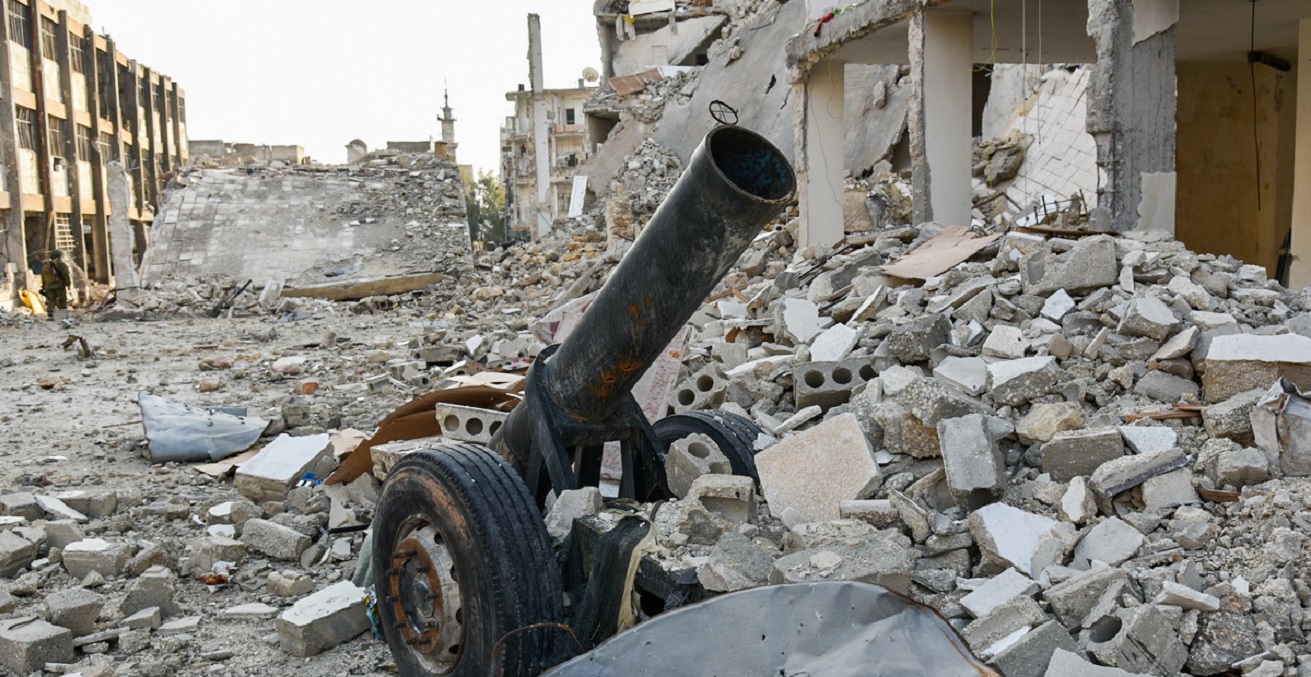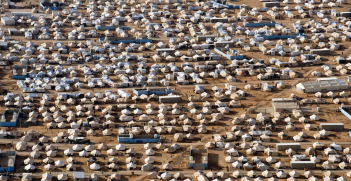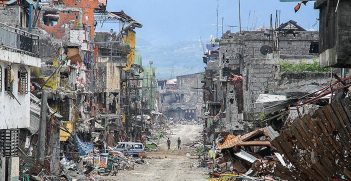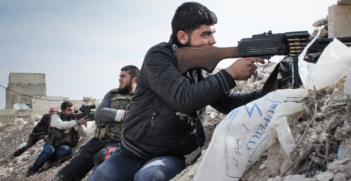Syria, The Task Ahead

Even with Islamic State defeated on the ground in Syria and the battlelines of the long-running war the subject of UN peace negotiations, the country remains torn by conflict. Could a recent Russia-US joint declaration be the beginning of the end?
The latest attempt to hold UN-sponsored talks in Geneva with the main parties to the Syrian conflict began last week but the talks have already stalled over demands by opposition delegates that Syrian president Bashar al-Assad should play no part in a transitional government. With the defeat of Islamic State (IS) on the ground, what hope is there that a clearer picture will emerge on whether the conflict on the battlefield might be reaching its final stages?
The issues that lie behind the current phase of the Syrian conflict cannot be over-estimated. While the chances of a breakthrough in defining mutually agreeable terms for peace negotiations remain minimal, the effective removal of IS from Syria at least provides a chance for the parties to work through some broader themes.
Most interesting in this context is the joint declaration agreed on 11 November in Danang, Vietnam, by the US and Russian presidents, a remarkable text barely noted in the media but which represents a clear definition of common objectives. Among the most significant points of agreement:
- commitment to the UN Geneva process (UN Security Council Resolution 2254) leading to elections under UN supervision;
- support for Syria’s “sovereignty, unity, independence, territorial integrity and non-sectarian character”; and
- the ultimate elimination of foreign forces and fighters from Syria.
While this may be brushed aside as another example of Vladimir Putin’s manipulation of Donald Trump, there are perhaps reasons for seeing it as a belated recognition by the US president that the only way out of the Syria mess is via Russian influence over Assad and with the help of Iran. This would end seven years of misguided US attempts to become a player in the conflict, scrabbling to find an agenda of its own beyond the destruction of IS. It also sends a strong signal that lopping off bits of Syria to suit the interests of Iran, Turkey or the Kurds, for example, is simply a recipe for a disaster likely to be even more prolonged than the last seven years of agony.
If Trump sticks to these terms of a broader understanding with Russia, he would effectively be abandoning the fumbled attempts since the Obama era to fantasise about the possibility of an Arab spring process in Syria. Obama’s calling for Assad’s removal–without any identification of the consequences that might bring– simply put well-motivated Syrian civilians into the firing line facing a regime determined to hold on to power. It inevitably led to the assumption that the world’s superpower would cover demonstrators’ backs. Sadly but inevitably, this simply paved the way for an armed opposition funded by numerous outsiders who had no interest in the sort of Syria defined in the second Danang dot point above.
The move to an armed confrontation transformed Syria, on a scale surpassing even post-2003 Iraq, into a playground for religious and ethnic fantasists on a global scale. The US (and many others) in 2011 simply failed to join the dots that led back not just to the Iraq meltdown post-2003, but to the Hama rebellion in Syria in 1982, as clear a demonstration as any that the Assad family has a brutal answer to armed dissent.
Even if Trump has quietly recognised that the only way out of this mess is to work through Russia, the talks will still be prodigiously complex. Any solution that meets the Danang list will have to discourage Turkey from extending its campaign against the Kurds onto Syrian soil, persuade the Kurds to limit their ambitions for a pan-Kurdish state, and temper Hezbollah’s bid to spread its role beyond Lebanon.
The deconfliction process will require sorting out problems one by one, not lumping them all into a bundle of issues spanning the region from Iran to the Mediterranean, often dressed up with clichés such as a Shi’a corridor spanning the region. Sure, the region has differences to pick over, but most of them have been around for 12 centuries. All the successful rulers over those centuries have shown that such differences have to be managed not manipulated to short-term advantage.
The Syrian battlefield remains a complex mess, even after the successful ousting of IS. There are still hotspots including virtually the whole of Idlib province west of Aleppo, the eastern fringes of the Damascus oasis, the Golan, the western edge of the steppe lapping across the main north-south transport corridor, and the largely empty central steppe (possibly destined to become Syria’s Sinai). Each involves a different set of complex local factors involving opposition elements that span the gamut from secular to ‘IS-lite’. Most are manipulated to some extent by outsiders that may have territorial ambitions within Syria. Turkey in particular has been quick to set up a presence across the norther border area, possibly mainly intended to prevent the Kurds setting up their own administrative structure.
The only way to prevent such erosion of Syrian sovereignty acquiring permanency is to see the return of a civil administration answerable to a unified Syrian state. The new Saudi strongman, Mohammad bin Salman, however, is still seeking to play his anti-Iran hand across all the Middle East’s fault lines. Given that most of bin Salman’s Middle East initiatives have had questionable results, and with the US possibly now identifying a need to discourage his enthusiasm to ignite Shi’a–Sunni tensions on a region-wide scale, the need for all players in Syria to back off a little is increasingly paramount.
In all this, is reconstruction a pipe dream? The task will be formidable, requiring decades and it must start with civilian housing and infrastructure to buttress the process of restoring normal life, encouraging the return of refugees and economic activity. Aleppo, once the country’s entrepreneurial heartland, should be the first focus. Even if Aleppo’s eastern quarter has been systematically turned to rubble, the last thing the Aleppines need is for outsiders to assume the city is entirely lost. Aleppo’s historic remains, for example, are often written off by commentators. I have closely followed the city’s agony for the last seven years, preparing the first history of the city in English for publication. My website brings together information based on visual sources on the course of destruction in the form of a cumulative list of buildings damaged or destroyed in the Syrian conflict. In the case of Aleppo, of the city’s 700 or so registered historic monuments, the number that have been eliminated or in substantial part toppled amounts to 16. Those which would require extensive rebuilding would add another 30. Those two categories amount to less than 7 per cent of the city’s historic fabric.
These figures are necessarily provisional and not based on professional damage assessments on the ground. Though some losses are grievous blows to the city’s pre-2011 reputation as the most picturesque trading centre of the Silk Route, these figures do not represent total destruction, even if many other buildings would require partial reconstruction. So why do the pundits consistently assume that the city is gone? There could be no worse blow for the citizens of Aleppo than encouraging popular assumptions that their once handsome and welcoming city is now a lost cause.
Ross Burns was Australian Ambassador in Syria from 1984 to 1987. Ross Burns’ ‘Aleppo, A History’ (Routledge 2017) is due to be published as a paperback in Jan 2018. His website can be found at http://www.monumentsofsyria.com/.
The article above, originally published in John Medadue’s Pearls and Irritations on 29 November, has been edited to update the reference to the Geneva talks.





